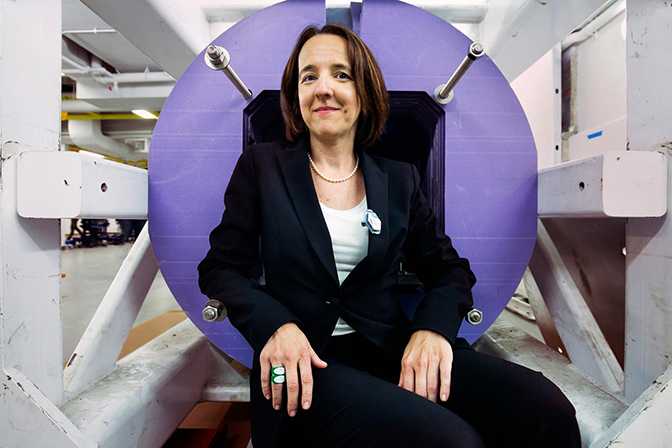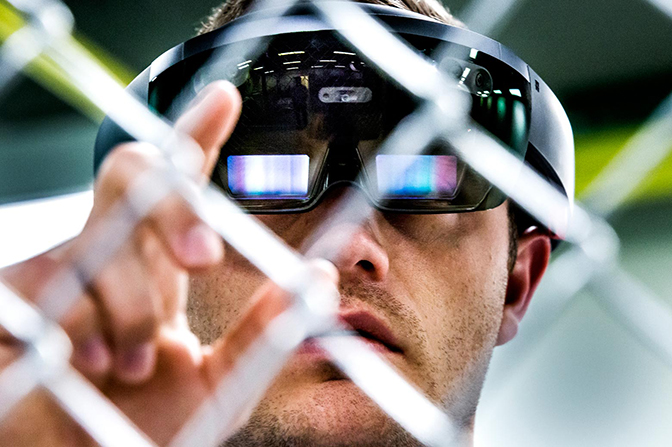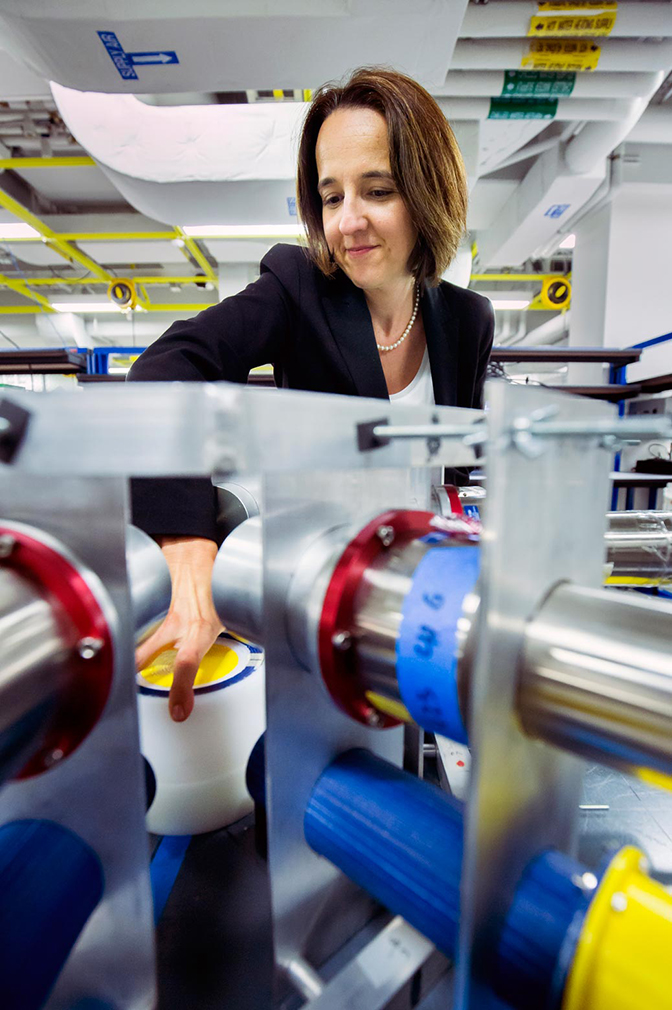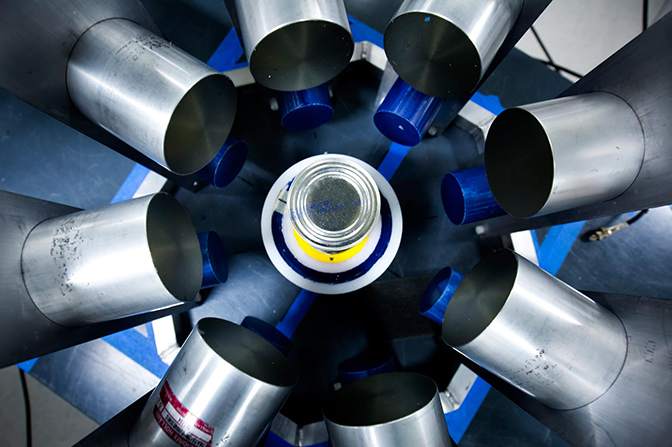Out of the Cold War’s shadow
“My God, what have we done?” The new technology of nuclear nonproliferation
“My God, what have we done?” The new technology of nuclear nonproliferation
These words echoed in the mind of Enola Gay co-pilot Robert Lewis after watching a radioactive ball of fire swallow Hiroshima on August 6, 1945 in the first attack of the Atomic Age. Tens of thousands of people were killed instantaneously. Burns, radiation sickness and other injuries brought the death toll to around 200,000. It was the world’s first look at a terrifying weapon that is still both coveted and abhorred.
The attacks on Hiroshima and Nagasaki set off a worldwide race to produce nuclear bombs. The mushroom cloud of a successful test sent a message to other countries: you mess with us, we’ll annihilate you. The international community tried to put on the brakes, but the past 70 years have seen more countries gradually arming themselves. In the heat of the Cold War, nuclear warheads piled up to a global peak close to 60,000.
[Read the Reddit Science AMA (Ask Me Anything) with Sara Pozzi.]
“Right now, the United States has 1,700 nuclear weapons ready to be delivered and another 2,700 in storage. Some are literally thousands of times more powerful than what was delivered in Hiroshima and Nagasaki,” said Paul Richards, a special research scientist at Columbia University. “And pointing at us from the Russian Federation, there are about 1,800 large nuclear weapons deployed now, ready to be delivered, and also nearly 3,000 on reserve.”
Still, the effort to prevent another Hiroshima – or worse – has been an unparalleled unifying force on the international stage. The great challenge is that outlawing nuclear technology is no solution; nuclear power has far too much to offer in emissions-free electricity, especially relevant in this moment when we are reckoning with the climate effects of conventional fuels.
WE’RE STILL LEFT WITH ABOUT 15,000 NUCLEAR WEAPONS TODAY. IT DOESN’T MAKE SENSE BY ANY MEANINGFUL STANDARD.
Alexander Glaser
The challenge instead is to prevent nuclear energy countries from becoming nuclear weapon states, along with efforts toward nuclear disarmament and the banning of nuclear tests. No country wants to take it on faith that the others are following the rules, so engineers need to design monitoring solutions that all sides can trust.
To bring treaty verification into the 21st century, the National Nuclear Security Administration offered $25 million to a team of engineers, scientists and policy experts at 12 universities and nine government laboratories. Their Consortium for Verification Technology is headed by Sara Pozzi, a professor of nuclear engineering and radiological sciences at U-M.
Pozzi has over 20 years of experience in nonproliferation, security and the monitoring of nuclear facilities. She spent several years at Oak Ridge National Laboratory, where she was part of a team working with Russia on new methods for disarmament verification.
“It’s really important to be able to verify a treaty to give confidence to the states that are part of the treaty, as well as to other states around the world, that the treaty can be implemented and enforced,” said Pozzi.
The work of the CVT touches nearly every aspect of nuclear nonproliferation, including the development of methods to better ensure that nuclear energy countries aren’t diverting materials for weapons, that any significant nuclear test around the world can be detected, and that countries engaging in disarmament are meeting their obligations.
As methods for monitoring nuclear activity become ever more precise, concerns about whether we can reliably catch treaty violations should fade, leaving the one big question: is the world ready to dismantle these weapons?

The dawn of the atomic age, before the world had ever heard of a meltdown, was a time of great optimism with the promise of virtually limitless energy. Nuclear nations like the U.S. wanted to share their expertise, on one condition: countries receiving nuclear power technology agreed never to obtain nuclear weapons.
Nuclear power has spread across the globe under the watchful eye of the International Atomic Energy Agency, founded in 1957. The IAEA’s role was formalized in the Nuclear Non-Proliferation Treaty in 1970.
“There are maybe 140 countries that have nuclear materials, and the IAEA is responsible for verifying that the countries have the material they claim to have – it hasn’t passed to nuclear weapon or secret programs,” said Zhong He, a professor of nuclear engineering and radiological sciences at U-M. He leads the CVT research group tasked with solutions for inspections and non-covert monitoring.
There are many points along the fuel cycle where nuclear material could be diverted or facilities misused. Likewise, the IAEA has many tools for identifying bad behavior. Still, the agency’s funding doesn’t extend to research and development, so it is left to the universities and national labs to push detection ahead.
The IAEA depends heavily on the use of helium-3 detectors to spot the neutrons that are critical to recognizing radioactive uranium and plutonium. These detectors have two big downsides. For one, they are slow to register neutrons, which muddies the timing of their neutron detections and makes them less precise at determining the concentrations of fissile materials that power reactors and bombs. Also, the helium-3 supply has tightened significantly since the end of the arms race: it is a byproduct of nuclear weapon production. As it becomes scarce, new detection materials are needed.
“In the CVT, we’re pioneering the use of these fast neutron detectors based on scintillators,” said Pozzi. “It’s really changing the way we’re doing detection for things like nuclear fuel.”
Scintillators react to radiation in forms like gamma rays and neutrons, producing light where the radiation passes through. Their big advantage, in addition to cost, is that they can sense neutrons quickly, picking apart fleeting chain-reaction fission events in uranium and plutonium materials.
The problem is that they light up not only when neutrons come through, but also in response to gamma rays, a form of electromagnetic radiation that is a step up from x-rays in energy. At first blush, the many gammas are indistinguishable from the much rarer neutrons, and this has always excluded plastic scintillators from the neutron detection game. But Pozzi and her colleagues are trying to turn this deal-breaking disadvantage into an advantage.
Her group has developed algorithms that can tell the difference between neutrons and gammas, and these are being further refined with help from Alfred Hero, a professor of electrical engineering and computer science at U-M. His algorithms are good at picking out rare, important events in a sea of similar but unimportant events: the neutron among ten thousand gamma rays, or the nuclear test among thousands of earthquakes.
While the neutron data is prized, Pozzi’s group goes beyond merely filtering out the gamma radiation – they’re trying to make it useful. By looking at neutrons and gamma rays together, they can tell the difference between forms of plutonium, whether it’s a compound destined for fuel rods or a metal that could be shaped into a weapon.
Going beyond basic detection, convenient radiation imaging could change the game in nuclear inspections. An IAEA agent could use a camera to determine whether there is radiation coming from unexpected locations – for instance, a corner of a room that might have been overlooked with a simple detector because all of the radiation was assumed to come from the fuel assembly offered for inspection. Now, researchers are developing new handheld detectors that not only identify radiation but pinpoint its source.
Zhong He is best known for his gamma cameras. Those that his company, H3D, makes are prized by nuclear safety professionals for their ability to identify tiny amounts of radioactive material – “radioactive dust,” as one user said. The IAEA has already bought two. He’s group is taking these cameras further by beginning to harness the neutron-detecting ability of the crystal at the heart of the camera.
Likewise, Pozzi’s combination radiation detectors are moving into imaging. CVT assistant director and U-M associate research scientist Shaun Clarke described their imager prototype: an array of centimeter-scale scintillating crystal pillars inside a handheld box. While He’s cameras superimpose the radiation image over the image of the room on a tablet computer screen, Pozzi’s group is experimenting with a Microsoft HoloLens virtual reality headset.
“We envision a world in which a nuclear inspector wearing a HoloLens could walk inside a room with a detector in his or her hand and be able to see the radiation source,” said Pozzi.

While inspections are indispensable, they aren’t a complete monitoring solution. The odds of catching a facility in the middle of an illicit transfer of materials are low. That’s why the IAEA’s toolkit also includes long-term monitoring technology such as video and radiation surveillance and satellite imaging.
In the CVT, Hero and other researchers are looking at ways to use advanced data science to take surveillance to the next level, merging data from different sources to identify anomalies that might indicate foul play. Hero leads the data analysis arm of the CVT, which is investigating how to leverage the data that is available.
“There is this notion of design data and non-design data,” said Hero. “Design data are, for example, specifically targeted campaigns to measure radiation levels under a treaty agreement. Non-design data, on the other hand, are just lying around and not collected for a nonproliferation purpose.”
One CVT project, led by Lawrence Carin, a professor of electrical engineering at Duke University, is trying to take advantage of non-design data with a method for spotting secret shipments out of known facilities. Because the IAEA obtains reports of all nuclear material comings and goings, it essentially has a transport network as design data. While some shipments are tracked with GPS, the routes and stopover times for others can be inferred – for instance, by comparing the time that a truck left one facility and arrived at another.
These routes can then be confirmed by satellite images, the non-design data. But it’s not just about confirming that shipments occurred as reported; by looking at slight variations in the shipping network, the researchers believe that they could turn up the times and places where undercover shipments may have occurred.
Another potential strategy is to observe power consumption at uranium enrichment plants. If the centrifuges are enriching uranium to higher, weapons-grade concentrations of U-235, it will be visible in the form of greater electricity use. Hero pointed out that the reported electricity bills could be compared to indirect measurements of the power line running into the facility – monitoring the magnetic field around it, the noise it makes or even the number of birds perched on the line. When more power is coming in, the magnetic field and noise rise while the heat deters the birds.
“We want to go beyond formal intelligence-gathering with cheap, pervasive technologies that can ensure – through the use of machine learning, image analysis and big data processing – a more effective way of detecting diversions and anomalies,” said Hero.
Among those anomalies are secret nuclear weapon tests.
WE ENVISION A WORLD IN WHICH A NUCLEAR INSPECTOR WEARING A HOLOLENS COULD WALK INTO A ROOM AND BE ABLE TO SEE THE RADIATION SOURCE.
Sara Pozzi, NERS
In the mid-1990s, many people believed the world was ready for a total ban on nuclear tests, so in 1996, the United Nations adopted the Comprehensive Test Ban Treaty, expecting it to sail through. It didn’t. Several nations didn’t sign, and several more – including the U.S. – signed but didn’t ratify.
Still, the 183 signatories (of the 193 states in the UN) have honored it and contributed to the funding of the International Monitoring System, a global network of 321 monitoring stations and 16 labs that can detect major nuclear tests anywhere in the world. The IMS was just getting started when India and Pakistan conducted their tests in 1998, but by the time North Korea began testing nuclear explosives in 2006, it was ready.
The international monitoring stations come in four flavors: seismic, measuring seismic waves through the earth’s crust; hydroacoustic, measuring sound waves in the ocean; infrasound, picking up inaudibly low sound waves in the atmosphere; and radionuclide, identifying radioactive particles found in the atmosphere.
The IMS was built up very quickly once the U.N. adopted the treaty, leaving little time to hone the monitoring techniques. Now, members of the CVT are trying to improve all aspects of the measurements.
Paul Richards of Columbia University, an expert in seismology, studies the blasts from nuclear tests and earthquakes, developing techniques to tell them apart even for relatively small nuclear explosions.
“There are several different types of seismic wave, and whether you have an earthquake source or an explosion source, that generates a different mix of seismic waves,” said Richards.
Right now, the IMS can pick up an underground blast anywhere in the world that exceeds 1,000 tons TNT equivalent. For context, the Tomahawk missiles launched at Syria in April of 2017 bore 0.5-ton chemical warheads. Once a nuclear weapon is no more powerful than a conventional bomb or warhead, it’s no longer considered a special threat from a military perspective.
In a thoroughly monitored region like North Korea, Richards said explosions of just a few tons – well below military significance – can be detected. For other regions, he is working closely with Hero to apply advanced statistical analysis to the problem, reducing the threshold to detect a nuclear explosion. This will give treaty signatories more confidence that violators can be caught and stopped.
In addition to improving the analysis of seismic data, CVT researchers are exploring improvements in other means of detection. For example, Milton Garcés, director of the Infrasound Laboratory at the University of Hawaii, is exploring how armies of iPhones can augment the existing arrays of infrasound sensors.
His group developed an app called RedVox that harvests the infrasound portion of sound registered by the iPhone’s built-in microphone and sends it off to his servers, where it can be analyzed. And because infrasound waves are so much longer than those produced by human voices, they can be gathered with a lower sampling rate, requiring less data and preventing the capture of conversations.
The smoking gun, so to speak, of a weapons test is the presence of radioactive gasses in the atmosphere. John Lee, a professor of nuclear engineering and radiological sciences at U-M, develops tools to predict where the wind will take these invisible fumes so that they can be captured and analyzed. By understanding and reducing the uncertainties in the models, his team improves the odds that investigators can identify the type and location of a suspected nuclear test.
While the IMS was designed to detect nuclear tests, Garcés pointed out these are usually advertised as a form of saber rattling. The most important benefit of better monitoring may be in de-escalating tensions, he said.
“For example, meteors could be incorrectly identified as being an attack. This has happened to us various times – when something just came out of the sky and blew up. And the first few hours to days can be tense,” he said. “If you can identify the signature quickly, you can de-escalate from a military to a natural hazard response. And that is really key to stability in the world.”

When the non-nuclear-armed countries agreed never to pursue nuclear weapons in the Nuclear Non-Proliferation Treaty, the nuclear-armed countries promised to disarm. This commitment was largely ignored during the Cold War, and even today, progress is slow. This is partly because warheads are hard to monitor, explained Alexander Glaser, an associate professor of public and international affairs, and mechanical and aerospace engineering, at Princeton University. Delivery vehicles, such as intercontinental ballistic missiles, are held in rather obvious silos, but warheads can be stored in innocuous-looking warehouses and move around during maintenance activities.
The U.S. and U.S.S.R. worked around this problem with their early arms reduction efforts; in 1972, they began limiting not the warheads themselves but the delivery vehicles. But the U.S. -Russia Strategic Arms Reduction Treaty (START) of 1994 and its successor New START limited actual warheads for the first time, putting a cap on how many warheads could be mounted on those missiles or loaded into bombers. The deployed warhead limit to be met by February 2018 is 1,550.
To make real progress with disarmament, the treaty verification community will need new techniques for monitoring the number of warheads each country has and verifying that warheads earmarked for dismantlement are rendered unusable. The CVT is looking for these new methods.
Nuclear warheads are especially difficult to count because countries want to protect classified information. “If this were simply a measurement problem, it would already be solved,” said Clarke.
He added that knowledge of the quantity of nuclear material plus its shape is enough to give away the explosive power of the nuclear weapon. Even the mass of the nuclear material alone is more than nations want to reveal.
Yet all an inspector really wants is a yes or no: this device contains a plausible amount of weapons-grade nuclear material, or it does not. So, many researchers are working to produce detectors that can give that simple answer without recording any classified information in a form that might be stored or intercepted. If these techniques existed, they could make a new kind of disarmament treaty feasible.
Some researchers, including David Wehe, a professor of nuclear engineering at U-M and science advisor to the CVT, are developing technologies that blur the detailed signals from the detectors very early on, before they can be diverted and recorded.
Glaser leads one of the projects that have taken this a step further, trying to stop classified information from even making it into the detectors. He calls it “zero knowledge” verification, inspired by cryptography. Through the CVT, his group worked with a team at Yale University to demonstrate that it was possible to confirm that two warheads are identical without ever recording design details.
Using non-electronic detectors that respond to neutrons by forming bubbles in a gel, Glaser’s team showed that they could confirm that two sets of metal blocks, which represented warheads, were identical in chemical composition, size and arrangement. They did this by preloading the detectors with the complement of the signature expected by measuring the blocks, like a photo negative. Then, when two identical sets of blocks were scanned with the neutron beam, two detector sets showed the same number of bubbles.
In an inspection, Glaser explained that a warhead could be removed directly from a missile and taken to a set of warheads with the same design that had been earmarked for dismantlement.
The preloading would be done by the country under investigation, and that complement would be wiped out during the scan. The inspectors would never see it, and it would never be recorded electronically. The investigator would choose which set of detectors would be used with which warhead.
If the country was trying to fake out its inspectors, it might try to sneak in some warheads without uranium or plutonium, making it look as though it was destroying more warheads than it really was. But these fakes could be spotted with a mismatch in the detector signals, and the differences would give away details of the warhead’s design.
The weakness of the strategy is that it relies on a warhead that the investigators believe is real. Still, Glaser points out that it would be risky and elaborate to present inspectors with an entire arsenal of missiles fitted with decoys and a set of identical fake warheads to “disarm.” Zero knowledge methods could go a long way toward enabling more aggressive disarmament targets.
“Better verification technologies are necessary to significantly reduce the number of nuclear weapons,” said Clarke. “If the U.S. and Russia each have five nuclear weapons, the ability to verify one is much more important.”

Five nuclear weapons each seems fanciful from where we are now.
“We’re still left with about 15,000 nuclear weapons today,” said Glaser. “It doesn’t make sense by any meaningful standard.”
Some CVT researchers can envision a world with just a handful of nuclear weapons – or even zero. In such a world, treaty verification is critical. Violators must be detected early and stopped before weapons are produced.
Judging by past progress, Glaser anticipates that it will take a long time just to get nuclear weapon numbers into the low hundreds, but once we’re there, the international community may have changed so much that zero doesn’t seem like such a difficult leap.
Pozzi is more cautious about the security of an arms-free utopia. “How can we verify zero weapons, especially in large states such as U.S. or Russia?” she asked. “Many would argue that keeping nuclear weapons to numbers in the hundreds for the U.S. and Russia provides a more stable solution.”
In the meantime, nuclear-weapon-free countries are tired of waiting around for weapons countries to disarm. They are taking action with a new treaty, adopted by 122 U.N. countries in July 2017, to ban nuclear arms. It opened for signatures in September.
It may not be long until, at least on the international stage, nuclear weapons are no longer a mark of power, but the mark of a pariah.